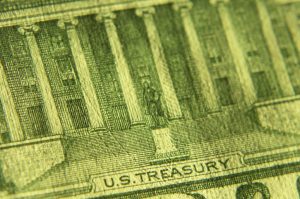
If you’ve paid attention to financial news over the past couple of weeks, you know that the inverted yield curve has dominated headlines. Historically, this phenomenon has been the most reliable sign of an impending recession as it has preceded each and every downturn in the past.
Yikes, right? Not necessarily. Many analysts point to factors that challenge the certainty of a looming recession. Before we jump into those factors, let’s refresh ourselves on what the inverted yield curve is.
Bond Yield Curves
When you hear someone talk about the inverted yield curve, they’re referring to the difference between the yields of 10-year and 2-year U.S. Treasury bonds1. Typically, long-term bonds offer greater yields because there’s more time and risk involved and there’s a lower demand for them. However, when investor confidence in the short-term economy falters, they buy up longer-term securities with lower interest rates to shield their money from negative returns. This increase in demand for long-term bonds effectively raises their price and lowers their yields.
It seems counterintuitive to tie your money up longer for less gain, which is why analysts were so concerned when the yield curve inversion spread was the largest it had been since 20073. Generally, the cause of the latest inversion has been attributed to the U.S.-China trade war, which has been a factor in slowing global growth.
But the title of this blog is “Inverted Yield Curve: Why you should take it with a grain of salt,” so while you should certainly consider this indicator’s historical record for predicting recessions, there are other factors that point to a recession being further in the future.
Lagging Realization
Each time the 10-year treasury yielded less than the 2-year, a recession eventually occurred. However, the lengths of time before each recession varied wildly4. For example, the time period between the initial inversion and the ensuing downturn ranged from 10 to 36 months for the last five recessions. So, there’s no reason to retreat into your fallout shelter just yet.
Strong Economic Indicators
According to the Commerce Department, sales at retail stores grew .7% in July, a healthy increase over the .3% increase in June5. Even amidst the U.S.-China trade war, consumer spending remains strong. And while business investment has weakened, job growth is steady, the unemployment rate continues to hover around a 50-year low, and wages are rising.
Mitsubishi UFJ Financial Group Managing Director and Chief Economist Chris Rupkey told CNBC that these benchmarks reflect a healthy economy.
“The rule of thumb for recession is three consecutive months of declining retail sales,” Rupkey said in an email.
Character of the Inversion
Other analysts say the significance of this latest inversion has been overblown and that how much the yield curve has inverted and for how long should be considered in its estimation as signal of recession6. For instance, if the yield curves invert briefly in a day, that’s not as foreboding as a weeks-long or even months-long inversion. Whether or not this current inversion has any staying power remains to be seen.
Other Factors
The global bond market may also be a cause of increased demand for long-term U.S. Treasury notes. Because U.S. bonds are yielding more than other foreign bonds, foreign markets are buying them up and driving the yields down7. What’s more, the lower long-term rates could help lower lending-rates for consumers (along with easing from the Fed) that could ultimately stimulate the economy.
Confidence is Key
Perhaps the most important factor in all this is consumer confidence. When consumer spending drops, the likelihood of a recession skyrockets. Consumers seem to have shrugged off the U.S.-China trade war so far, but time will tell if all this squawking over inverted yield curves and other recession signals will cause them to tighten their purse strings.
For more financial information, follow NEXT Financial Group, Inc. (NEXT) on Facebook and LinkedIn.
- https://fortune.com/2019/08/13/recession-benchmark-timing-stock-market/
- https://www.cnbc.com/2019/08/14/the-inverted-yield-curve-explained-and-what-it-means-for-your-money.html
- https://www.cnbc.com/2019/08/28/yield-curve-inversion-not-just-a-recession-switch-bespoke-paul-hickey.html
- https://fortune.com/2019/08/13/recession-benchmark-timing-stock-market/
- https://www.cnbc.com/2019/08/15/us-retail-sales—july-2019.html
- https://www.cnbc.com/2019/08/15/the-yield-curve-doesnt-necessarily-mean-a-recession-will-happen.html
- https://www.cnbc.com/2019/08/27/jim-cramer-on-recession-fears-i-think-the-yield-curve-linkage-is-wrong.html






